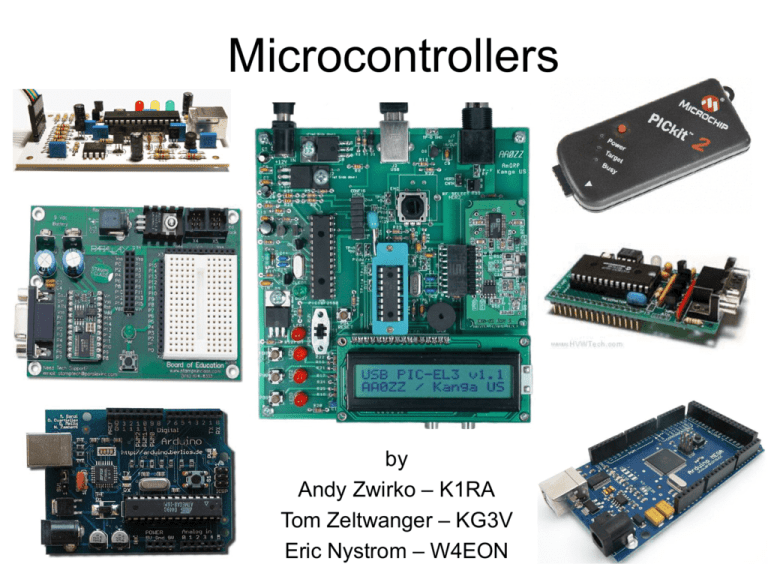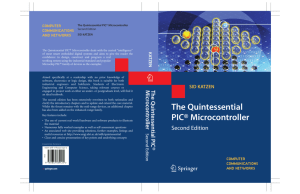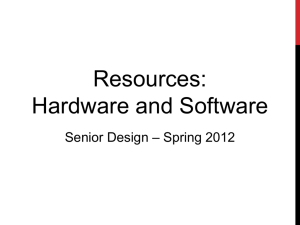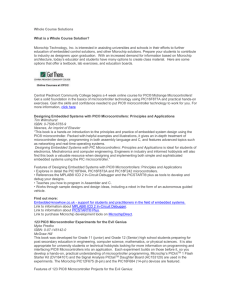Micro-controllers
advertisement

Microcontrollers by Andy Zwirko – K1RA Tom Zeltwanger – KG3V Eric Nystrom – W4EON Overview • • • • • • What are microcontrollers? Microcontrollers vs. microprocessors Where are microcontrollers used? Popular microcontrollers & vendors Programming microcontrollers Microcontroller projects (Eric, Tom, Andy) What is a Microcontroller? • An embedded, low power (uW/nW) computer that usually runs a dedicated task • An interrupt driven device providing real time, predictable responses to events • A self contained device with no external address and data buses What is a Microcontroller? • A microcontroller (µC, uC or MCU) is a single integrated circuit that contains the four major parts of every computer system • A device optimized for control applications What is in a Microcontroller? • All computers have a CPU (central processing unit) that executes programs What is in a Microcontroller? • A computer has some type of memory where it can store variables and instructions or steps • Memory may be RAM, ROM, (E)EPROM, Flash What is in a Microcontroller? • Computers have a clock or oscillator that determine the speed of program execution What is in a Microcontroller? • Computers have various input and output (I/O) capabilities to support various peripherals. What is in a Microcontroller? • Microcontroller range from 8 – 40+ pin packages • Extra pins provide analog and digital I/O options • 8, 16, 32 & 64 bit instructions & data controllers Where To Use a Microcontroller? • We need to flash an LED or light 3 times • Manually you would have to push button 3 times Where To Use a Microcontroller? • A microcontroller would allow sensing the button • The uC and its program could then flash the LED based on its system clock and pgm timer Where To Find Microcontrollers? • Microcontroller are found everywhere! • uC’s are considered embedded systems Microcontrollers in Ham Radio Popular Microcontrollers • Early day (1970’s/80’s) – Intel 8048 – Intel 8051 – Zilog Z8 – Motorola 68HC05 Popular Microcontrollers • Current day – Microchip PIC / PICAXE – Amtel AVR / ATmega – Parallax BASIC Stamp Microchip PIC 16F628 Specs • • • • • • • Programmable Intelligent Controller 8-bit CMOS processor 4 MHz internal oscillator 35 instructions Single cycle execution (RISC). 200ns instruction execution Non-volatile memory: – Flash program memory (3.5K bytes) – EEPROM data memory (128 bytes) • Volatile memory – RAM data memory (224 bytes) Microchip PIC 16F628 Specs • • • • • • • • 1 digital USART (async. RX/TX) 16 I/O pins w/ individual direction ctrl 1 Capture/Compare 16-bit 1 PWM peripheral 10-bit 2x 8-bit & 1x 16-bit timers (48 KHz) 2 Comparators (int. or ext. reference) Programmable voltage reference Voltage operation 2 to 5.5 VDC – 100 nA @ 2 VDC standby – 120 uA @ 1MHz & 2 VDC Microchip PIC 16F628 Pin Out • PIC pins and associated functions • Some are dual purpose Programming Languages for the PIC C Source File Assembly Language File C Compiler/Linker Assembler/Linker Device Programmer PIC Instruction Set W – The W register (or accumulator) is used as temp storage for many instructions f – “f” represents a user defined variable or system memory location k – “k” represents a literal number or a defined constant d – The value or “d” (0 or 1) determines where the numerical results is stored W (d=0) or f (d=1) b – “b” represents a particular bit in a 8-bit memory location (7,6,5,4,3,2,1,0) Programming the PIC (S/W) • MPLAB Integrated Development Environment (IDE) • Assembly for free, C compilers cost $$$ Programming the PIC (H/W) • Hardware programmer and associated pins PIC Circuit and Program • Simple circuit and program that blinks an LED on pin 6 (RB0) of a PIC16F628 PIC Kits • PICKit2 - $50 – www.microchip.com • PICEL-III - $65 – www.kangaus.com • PIC LAB - $120 – www.apogeekits.com Atmel AVR ATmega168 Specs • • • • • • • • • Advanced Virtual RISC 8-bit core 16 MHz clock Single cycle instruction 100 instructions Hardware Multiplier Flash: 16 Kbytes w/ Boot Code EEPROM: 512 bytes SRAM: 1Kbytes Atmel AVR ATmega168 Specs • • • • • • • • • • • • • • • • 32 registers 2x 8-bit timers 16-bit timer Real Time Clock w/ oscillator 3x PWM channels 8x channel ADC 10-bit Two wire serial interface Master/Slave SPI Serial Interface Program Serial USART Watchdog Timer Analog Comparator 23x I/O lines AVR program cable 24x external interrupts On-chip debugging through JTAG Simple programming (LPT port, 4 resistors & AVRDUDE) 1.8-5.5 VDC / 0.5uA – 3.6mA Atmel AVR ATmega168 Pin Out • AVR pins and associated functions • Some are dual purpose ATMega168 Instruction Set Arithmetic ADD Rd, Rr ADC Rd, Rr ADIW Rd+1:Rd, K6 SUB Rd, Rr SUBI Rd, K8 SBC Rd, Rr SBCI Rd, K8 SBIW Rd+1:Rd, K6 INC Rd DEC Rd AND Rd, Rr ANDI Rd, K8 OR Rd, Rr ORI Rd, K8 EOR Rd, Rr Arithmetic COM Rd NEG Rd CP Rd, Rr CPC Rd, Rr CPI Rd, K8 SWAP Rd LSR Rd ROR Rd ASR Rd MUL Rd, Rr MULS Rd, Rr MULSU Rd, Rr FMUL Rd, Rr FMULS Rd, Rr FMULSU Rd, Rr Bit & Other BSET s BCLR s SBI A, b CBI A, b BST Rd, b BLD Rd, b NOP BREAK SLEEP WDR Transfer MOV Rd, Rr MOVW Rd+1:Rd, Rr+1:Rr IN Rd, A OUT A, Rr PUSH Rr POP Rr LDI Rd, K8 LDS Rd, K16 LD Rd, X LD Rd, -X LD Rd, X+ LDD Rd, Y+K6 LD Rd, -Y LD Rd, Y+ LDD Rd, Z+K6 LD Rd, -Z LD Rd, Z+ Transfer STS K16, Rr ST X, Rr ST -X, Rr ST X+, Rr STD Y+K6, Rr ST -Y, Rr ST Y+, Rr Branch Jump RJMP K12 CPSE Rd, Rr IJMP SBRC Rr, b EIJMP SBRS Rr, b JMP K22 SBIC A, b SBIS A, b BRBC s, K7 BRBS s, K7 STD Z+K6, Rr ST -Z, Rr ST Z+, Rr LPM LPM Rd, Z LPM Rd, Z+ ELPM ELPM Rd, Z ELPM Rd, Z+ SPM ATmega has multiplication hardware, 32 registers, pointer registers (X,Y,Z), register addressing, I/O ports, access read-only data in program memory, conditional branches Call RCALL K12 ICALL EICALL CALL K22 RET RETI Programming the AVR • AVR Studio 5, supports C, Pascal, Basic, free • GNU gcc support, avr-gcc, WinAVR AVR ATmega Kits • STK300 - $130 – www.microcontrollershop.com • ATMEGADEVBRD - $40 – www.futurlec.com • Arduino Uno - $30 – www.sparkfun.com Arduino (ATmega based) • The 555 of the 21st century • Open Source Hardware – Open architecture for expansion – Shield add-ons: • USB, ethernet, wireless/XBee, motor, MIDI, BT, LCD • Open Source Software Development Tools – Integrated Development Environment – Rich library sets for supporting peripherals I/O • Linux, MacOSX and Windows support Arduino Instruction Set Programming the Arduino FARA Member Microcontroller Projects • Tom KG3V – CWlink • Eric W4EON – Antenna Measurements • Andy K1RA – WSPR Beacon CWlink An embedded CW Project by Tom Zeltwanger KG3V Based on the Arduino Board CWlink Objectives • Learn about Arduino boards and development • Demonstrate useful Ham Arduino App • Start by sending canned CW text • Upgrade to accept hand-keyed CW for record/playback (preserve “fist”) • Long Term - Untethered rig operation for CW using a Keyer (vs. keyboard) Arduino Duemilanove Board • • • • Microcontroller ATmega168 Clock Speed 16 MHz Operating Voltage 5V Input Voltage 7-12V • Digital I/O Pins 14 – 6 provide PWM output • Analog Input Pins 6 • DC Current per I/O Pin 40 mA • DC Current for 3.3V Pin 50 mA • Flash Memory 16 KB – 2 KB used by boot loader • SRAM 1 KB • EEPROM 512 bytes CWlink Architecture Rig Serial Output Serial – Wireless Link Arduino Board Serial Input Keyer Cwlink Keyer State Diagram Power Up Cal Failed (loop) Init Init Success Cal Cal Success Record Mode Switch Change 5 Sec Timeout Playback Mode Switch Change PIC, DDS & Return Loss Bridge An Antenna Measurement Project by Eric Nystrom W4EON Based on the PIC 16F1827 Signal Generator for Antenna Analyzer • PIC 16F1827 – 18 pin device – 32 MHz – Accurate internal clock so no crystal needed • Pins used – – – – 3 pins to control DDS80 2 pins for Serial IO 1 pin for AD converter 3 pins for in circuit programming Analyzer Development • Development Tools – CCS C compiler – CCS ICD 64 programmer (in circuit) • Code – – – – 2 Files 600 source lines Reused code from other projects Only minor modifications for this project • Resources: – ROM used: 1830 words (45%) – RAM used: 52 (14%) • PIC code functions – Serial Interface – Set frequency of DDS – Read AD converter Architecture Diagram In Circuit Programmer Programming Control JAVA Program for Plotting and Analysis Serial Link PICC 16F1827 Bridge Voltage Return Loss Bridge Antenna DDS Control DDS 80 RF To Bridge • About 8 hours of development time. • Code for analysis and plotting is contained in a PC program written in Java. Lessons Learned The bridge is a wideband device. The bridge measures what the antenna is receiving as well as the component from the signal generator. Measurement differs from day to night. Weak Signal Propagation Reporter (WSPR) 160m to 6m Beacon Board Project by Andy Zwirko K1RA Based on the PICEL-III Board PICEL-III Development Board • PIC Programmer for 18-pin PICs via PC USB Port made by AA0ZZ • Hardware components: – – – – – – – – – PIC 16F628A 2x16 line LCD (with backlight) Rotary encoder Three general purpose pushbuttons Three LEDs Speaker with driver Stereo jack for CW paddle input Stereo jack with transistor driver to key TX Transistor conditioner for converting lowlevel signals for PIC input (frequency counter) detection – Multi-purpose BNC connector for signal I/O – Expansion port for AmQRP DDS-30/60 AmQRP DDS-60 VFO • Analog Devices AD9851 DDS • 0-60 MHz programmable oscillator • 5th order elliptic filter – harmonics down 40db • Adjustable RF-amp – 10-40 mW • 8 pin header WSPR Beacon Code • AA0ZZ created signal generator program for PICEL-III (0-60 MHz) • W3PM modified AA0ZZ program – modulate signal generator with WSPR “whisper” encoding scheme TX-only – ~2700 lines of code w/ comments – WSPR signal conveys call sign, Maidenhead grid locator and power level – Example: KW4VA FM18 17 – Forward Error Correction (FEC) is employed – Modulation scheme narrow-band 4-FSK modulation. KW4VA Beacon DX Last 24 Hours Call Grid Km N8TWX EN83 770 W3HH EL89 1149 KC8NN EN66 1167 WA9FIO EN43 1254 WA5ETV EM15 1741 W5OLF DM78 2396 • Stations spotting / hearing WSPR beacon in the last 24 hours (30/40m) • KW4VA beacon running 20 mW and attic antenna fed with 300 ohm feed line KW4VA WSPR Top 20 Best DX Date / Time Beacon Freq SN DT Grid Pwr Reporter Rgrid Km Az 2011-02-26 02:14 KW4VA 10.140268 -21 0 FM18cr 0.02 CT2IWW IN51wf 5778 64 2011-03-08 00:38 KW4VA 14.097096 -26 0 FM18cr 0.02 WB2FXO CM94su 3789 277 2011-02-15 00:00 KW4VA 14.097127 -22 -1 FM18cr 0.02 WA7KGX CN85no 3742 297 2011-02-11 17:12 KW4VA 14.097169 -27 -1 FM18cr 0.02 VE6OG DO33 3127 313 2011-02-27 05:38 KW4VA 7.040176 -27 0 FM18cr 0.02 KE7LEU DN41 2827 287 2011-03-08 03:02 KW4VA 14.097189 -26 -1 FM18cr 0.02 KI7AB DM65qg 2578 270 2011-02-19 04:42 KW4VA 10.140253 -26 0 FM18cr 0.02 W1CDO DM73 2507 265 2011-02-19 03:24 KW4VA 10.140257 -26 0 FM18cr 0.02 W5OLF DM78hb 2396 277 2011-02-11 07:42 KW4VA 7.040164 -27 0 FM18cr 0.02 W0DHB DN70kc 2344 282 2011-02-27 17:36 KW4VA 21.096018 -25 -1 FM18cr 0.02 KN5X EM10dm 2032 249 2011-02-13 23:54 KW4VA 14.097065 -24 0 FM18cr 0.02 N5VP EL29jj 1906 242 2011-03-07 15:08 KW4VA 14.097176 -31 0 FM18cr 0.02 K5XL EM12kp 1868 255 2011-02-18 07:54 KW4VA 7.040186 -28 0 FM18cr 0.02 KE7A EM12kx 1852 256 2011-02-19 02:36 KW4VA 10.140253 -26 0 FM18cr 0.02 AD4PT EM12kx 1852 256 2011-02-10 07:56 KW4VA 7.040155 -29 0 FM18cr 0.02 K5ARH EM30xe 1612 238 2011-02-16 09:36 KW4VA 7.040167 -24 0 FM18cr 0.02 KC8JNV EN11xe 1576 286 2011-03-02 03:14 KW4VA 7.040183 -29 0 FM18cr 0.02 N0SF EM29mh 1482 278 2011-02-10 04:12 KW4VA 7.040146 -25 0 FM18cr 0.02 K0GUN EM36cu 1419 267 2011-02-22 14:12 KW4VA 14.097175 -17 -1 FM18cr 0.02 KC0BMF EN31be 1396 286 2011-02-26 23:24 KW4VA 10.140234 -17 0 FM18cr 0.02 N0UR EN33 1380 297 • Best DX copying / spotting KW4VA WSPR beacon over the last 30 days Information and Links • Common Microcontrollers – http://en.wikipedia.org/wiki/List_of_common_microcontrollers • Microchip Technologies – www.microchip.com – Microcontroller chips, development kits and MPLAB IDE • PIC – http://en.wikipedia.org/wiki/PIC_microcontroller • Atmel – www.atmel.com – Microcontroller chip, development kits and AVRStudio • ATmega – http://en.wikipedia.org/wiki/Atmel_AVR • Arduino – www.arduino.cc – Open source hardware info, software tools, projects, kit vendors • AVR Community – http://www.avrfreaks.net/ – ATmega forums, discussions, information groups






